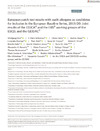Identificador persistente para citar o vincular este elemento:
https://accedacris.ulpgc.es/jspui/handle/10553/113988
| Título: | European patch test results with audit allergens as candidates for inclusion in the European Baseline Series, 2019/20: Joint results of the ESSCA(A) and the EBSB working groups of the ESCD, and the GEIDAC(C) | Autores/as: | Uter, W Wilkinson, SM Aerts, O Bauer, A Borrego Hernando, Leopoldo Buhl, T Cooper, SM Dickel, H Gallo, R Gimenez-Arnau, AM John, SM Navarini, AA Pesonen, M Ponyai, G Rustemeyer, T Schliemann, S Schubert, S Schuttelaar, MLA Valiukeviciene, S Wagner, N Weisshaar, E Goncalo, M |
Clasificación UNESCO: | 32 Ciencias médicas 320106 Dermatología 320701 Alergias |
Palabras clave: | Baseline series Benzisothiazolinone Clinical epidemiology Contact allergy Decyl glucoside, et al. |
Fecha de publicación: | 2022 | Publicación seriada: | Contact Dermatitis | Resumen: | Background: In 2019, a number of allergens (haptens), henceforth, “the audit allergens,” were considered as potential additions to the European Baseline Series (EBS), namely, sodium metabisulfite, 2-bromo-2-nitropropane-1,3-diol, diazolidinyl urea, imidazolidinyl urea, Compositae mix II (2.5% or 5% pet), linalool hydroperoxides (lin-OOH), limonene hydroperoxides (lim-OOH), benzisothiazolinone (BIT), octylisothiazolinone (OIT), decyl glucoside, and lauryl glucoside; Evernia furfuracea (tree moss), was additionally tested by some departments as well. Objectives: To collect further data on patch test reactivity and clinical relevance of the audit allergens in consecutive patients across Europe. Methods: Patch test data covering the audit allergens in 2019 and 2020 were collected by those departments of the European Surveillance System on Contact Allergies testing these, as well as further collaborators from the EBS working group of the European Society of Contact Dermatitis (ESCD), and the Spanish Grupo Español de Investigación en Dermatitis de Contacto y Alergia Cutánea. As patch test outcome, reactions between day (D) 3 and D5 were considered. Results: Altogether n = 12 403 patients were tested with any of the audit allergen. Positive reactions were most common to lin-OOH 1% pet. (8.74% [95%CI: 8.14–9.37%]), followed by lin-OOH 0.5% pet., and lim-OOH 0.3% pet (5.41% [95% CI: 4.95–5.89%]). Beyond these terpene hydroperoxides, BIT 0.1% pet. was the second most common allergen with 4.72% (95% CI: 4.2–5.28%), followed by sodium metabisulfite 1% pet. (3.75% [95%CI: 3.32–4.23%]) and Compositae mix 5% pet. (2.31% [95% CI: 1.84–2.87%]). For some allergens, clinical relevance was frequently difficult to ascertain. Conclusions: Despite many positive patch test reactions, it remains controversial whether lin- and lim-OOH should be tested routinely, while at least the two preservatives BIT and sodium metabisulfite appear suitable. The present results are a basis for further discussion and ultimately decision on their implementation into routine testing among the ESCD members. | URI: | https://accedacris.ulpgc.es/handle/10553/113988 | ISSN: | 0105-1873 | DOI: | 10.1111/cod.14059 | Fuente: | Contact Dermatitis [ISSN 0105-1873], v. 86(5), p. 379-389 |
| Colección: | Artículos |
Citas SCOPUSTM
29
actualizado el 08-jun-2025
Citas de WEB OF SCIENCETM
Citations
29
actualizado el 08-jun-2025
Visitas
166
actualizado el 07-dic-2024
Descargas
142
actualizado el 07-dic-2024
Google ScholarTM
Verifica
Altmetric
Comparte
Exporta metadatos
Los elementos en ULPGC accedaCRIS están protegidos por derechos de autor con todos los derechos reservados, a menos que se indique lo contrario.
